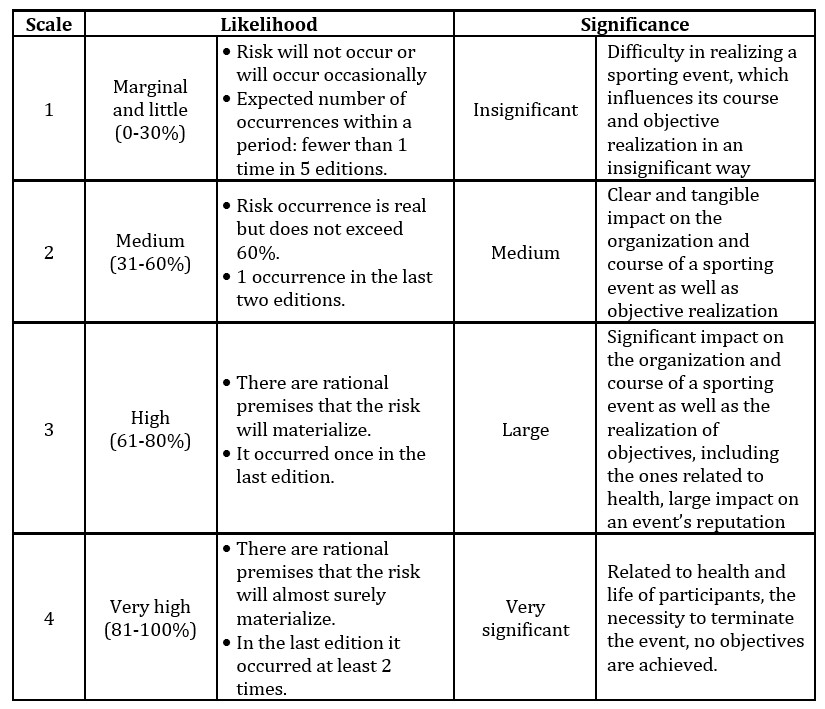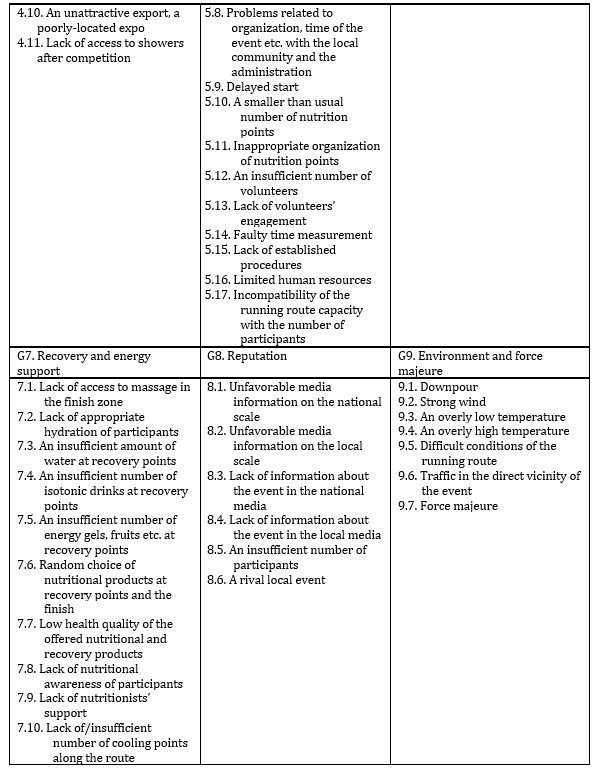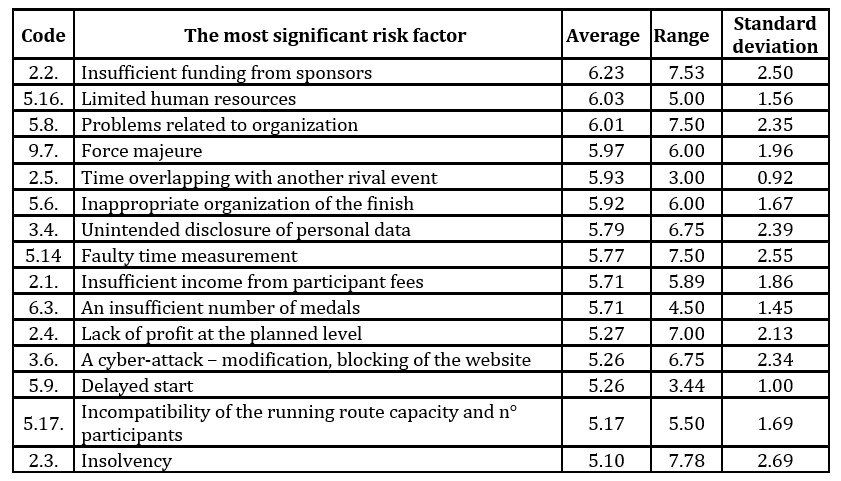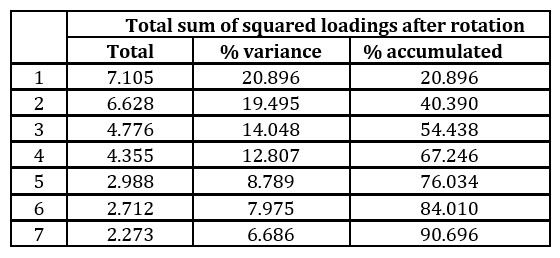Introduction
Not only is recreational running a physical activity but also amounts to the modern lifestyle model for a significant portion of the society. It is relatively inexpensive, as it does not require any special sports facilities (Petridis, 2015).
Relevant data suggest that 58% of amateur runners in Poland are willing to participate in professional running events (Raport Polska Biega, 2014). Such participation needs the implementation of training plans and significant time spending of both runners and their families. It also contributes to the growing sport tourism and the emergence of new risks (Hitchings & Latham, 2017).
In 2010 almost 800 different runs were registered in Poland, while in 2015 we could observe an increase of nearly 132% in comparison with 2010 (1,856 events). More than 2,500 runs were registered in Poland in 2018 (www.maratonypolskie.pl). 74,971 runners participated in the largest 12 Polish half marathons in 2019 (the number excludes the participants who did not complete the run). It is a 2% decrease in comparison with 2018 (76,598).
The decreasing number of finishers accompanied by the growing number of runs on the sport market encourage their organizers to better the quality and efficiency of the events by implementing professional management tools (Leopkey & Parent, 2009a).
Professional management is a necessary element for the efficient attainment of the objective of organizing the run in a proper way (Piekarz, Jenkins, & Mills, 2015). Threats to the safety of participants and viewers, the risk of a terrorist attack, and the need to protect personal data are increasingly important nowadays (Lamont & Kennelly, 2012). An early understanding of the risk level, various risk issues, complexity and uncertainty related to risk management, supports the determination of the project scope and the eventual success of the running event (Nohr, 2009).
Formal management of the project, which is the organization of a sporting event in compliance with a recognized methodology, is not implemented by 51% of sports events’ organizers in Poland. 78% of them do not formally estimate the risk of organizing their events (Miśniakiewicz & Łuczak, 2014). It is likely that organizational decisions are not made in the optimal manner, no significant risks are identified and, consequently, they cannot be properly mitigated (Hanstad, 2012). As a result, a sports event will probably not produce the expected benefits and its course may be significantly disturbed (Helms, 2011; Reid & Ritchie, 2011). Such disturbance can lead to further risks linked with damages to the organizer’s reputation and participant dissatisfaction (Nohr, 2009; Moyle, Kennelly, & Lamont, 2014). Major incidents and deaths in top runs have obviously contributed to exaggerated public worries about their safety and made their organizers avail of professional risk management (Bjarnason & Cannell, 1999).
There are no significant mandatory legal requirements for risk management in large-scale runs today despite the fact that it surely allows for the identification, assessment and mitigation of risks (Ammon & Brown, 2007).
The exploration of the extent running event organizers are able to provide a safer environment for participants and manage the risk of their events is certainly challenging for researchers.
Literature on risk management of running events organization
Risk can be seen as “any future incident that will negatively influence the event” (Bowdin, Allen, O’Toole, Harris, & McDonnell, 2006), whereas risk management as a tool for “minimizing liabilities and maximizing opportunities” (Silvers, 2008).
Sporting events occur in conditions of uncertainty caused by both internal and external factors (DSDM Consortium, 2010). Sometimes risk and uncertainty are considered synonymous (DSDM Consortium, 2010, p.12). The ISO 31000 standard defines risk as the effect of uncertainty in pursuing a set goal (ISO 31000, 2018) and emphasizes the management of diversified risk. Context determination, risk assessment (including risk identification, analysis and assessment) and risk treatment are essential parts of risk management (ISO 31000, 2018).
According to relevant literature, risk management is a proactive process, as it aims at controlling the effect of unforeseen issues or incidents taking place during the event (Hanstad, 2012; Ammon & Brown, 2007; Łuczak & Miśniakiewicz, 2011).
Risk management in large-scale sporting events gains importance and should be examined from different angles (Emery, 2010; Moyle et al., 2014). Most papers on risk management and reports on sport event risk notably come from the US, Canada and Australia (Helms, 2011; Nohr, 2009; Masteralexis, Carol & Hums, 2014). In Europe, the problem of the organization of large-scale running events and their risk assessment have been rarely researched (Łuczak & Miśniakiewicz 2014; Kose, Argan & Argan, 2011).
Researchers have focused on injuries (Hespanhol, Pena Costa, & Lopes, 2013; Linton & Valentin, 2018), security and crowd control (Giulianotti & Klauser, 2010), effect of terrorism (Toohey & Taylor, 2008; Giulianotti & Klauser, 2010), facility management (Preuss, 2007), actual losses caused by an event (Crompton, 1995), spectator aggression and hooliganism and lack of organizational planning (Getz, 2002). The overall impact of a sporting event on stakeholders (Leopkey & Parent, 2009a), risk management strategies by stakeholders (Parent & Séguin, 2007), as well as practices (manager profile, skills required and critical success factors) in sporting events (Emery, 2010) have also been highlighted.
In addition, professional literature identifies risk issue categories by stakeholder groups. Research has provided the list of 15 risk issue categories significant when coping with risk management in sporting events: environmental, financial, human resources, infrastructure, interdependence, legacy, media, operations, organizing, participation, political, relationship, visibility and human resources. The present research in the assessment of risk management in large-scale running events originates from these considerations (Leopkey & Parent, 2009a).
Researchers mostly have analyzed sporting events of international importance embraced in the social, economic, promotional or planning context (Boo & Gu, 2010).
Methods
This paper was preceded by the preparatory research (1) of 2017 and the proper research (2) conducted in 2017-2018. They aimed at assessing risk and analyzing data in the context of determining the type of managerial decisions within half marathon organization. The research resulted in: (1) the identification of risk factors related to organizing 21K runs, (2) the assessment of risk factors along with factor grouping and prioritization (table 1).
Table 1: Characteristics of preparatory and proper research

I created a list of risk factors on the basis of the relevant professional literature (Leopkey & Parent, 2009a), own experience and legal requirements in Poland and classified them with the use of the Ishikawa diagram (Łuczak, Matuszak-Flejszman, 2007). Next, the list was discussed by experts (via Internet). Most of the experts exchanged remarks several times (5-9), which resulted in the modification of the factor list. These actions became the basis of the research questionnaire. The risk factors were assessed within the proper research on the scale ranging from 1 to 4 according to their significance and likelihood (table 2).
Table 2: Characteristics of selected values in the proper research

The research was supported by the e-risk IT platform (e-risk.pl). It allows for multi-dimensional configurability in the context of methodology and risk factors. All 21K runs were held in cities on flat or moderate terrain in Poland. The events were similar in many aspects, e.g. climate conditions, participant profile, the declared standard of organization, legal regulations relevant to the organization process. The factors analyzed in the paper led me to the conclusion that each expert’s assessment should be treated individually and not a concrete half marathon.
Risk assessment aims at determining priorities related to additional security measures, which reduce risk to an acceptable level. These priorities were established in the statistical analysis of factors with tagging the major ones.
Reliability analysis (Cronbach, 1951) was applied with the use of the Cronbach’s alpha statistics to confirm the research instrument’s (a questionnaire prepared during the preparatory research) adequacy (Cronbach, 2005).
The factor analysis was used to distinguish risk factor groups. This method is considered unobjective, nevertheless, it is very important while exploring the structure of varied data (Balicki, 2013). It allowed for categorizing observations in an adequate way so as the groups were coherent due to variables (internally cohesive), but, at the same time, dissimilar to others (i.e., characterized by external isolation – Walesiak & Gatnar, 2016).
At the stage of selecting variables, I decided to examine the impact of factors of the highest risk. Therefore, variables were grouped on the basis of the arithmetic average of risk assessment, and then I applied both scree plot and the minimal risk value criterion at level 4 (in order to distinguish the risks larger than minimal probability and consequences).
I also deemed the selection of insignificant variables is an incorrect approach as it may hinder the emergence of a coherent or relevant class difference within the set. The variables were then standardized (with the average and standard deviation) (Wilk, Pietrzak, Bivand, & Kossowski, 2015).
The factor analysis aimed at distinguishing a new set of variables – a set, which is less numerous than the original one, but can expose its variability. These factors should retain a significant portion of information included in the original variables (Walesiak & Gatnar, 2016).
Risk assessment results and discussion
The research led to determining 75 risk factors grouped into nine sets: Safety (G1), Budget and finance (G2), Information (G3), Comfort and satisfaction of participants (G4), Other organizational aspects (G5), Start package (G6), Recovery and energy support (G7), Reputation (G8), Environment and force majeure (G9). Within the factor groups, the specific risk factors were indicated.
Table 3: Groups and risk factors – the result of the preparatory research


Experts highlighted the significance of factors linked with the physical safety of participants and organization. They also underlined risks relating to accidents on the route, bad health condition of participants, as well as terrorist and bioterrorist threats. Moreover, personal data protection, especially compliance with GDPR, was considered significant. Experts clearly noticed the risk of not assuring participant satisfaction, as they took account of issues linked with start packages, start organization, route attractiveness and deposit organization. Finally, the risk factors resulting from the preparatory research were used in risk assessment conducted in the proper research. The grouping was arbitrary and then discussed with experts. The Cronbach’s alpha statistics result reached the level of 0.933 (21 positions). In light of the classical interpretation, the coefficient should have the minimum value of 0.6, whereas the preferable value of the coefficient is approx. 0.9. Therefore, the internal cohesion of the research instrument was confirmed.
The presentation of the proper research results concentrated on the classical approach to risk assessment – the statistical analysis of risk factors’ average values accompanied by tagging the ones of the highest risk and largest frequency.
The scree plot led to the emergence of 5 risk factor groups: (i) the most significant (15) – the average value from 5.10 to 6.23, (ii) less significant (21) – the average value from 4.14 to 4.94, (iii) neutral (18) – the average value from 3.14 to 3.90, (iv) of little significance (9) – the average value from 2.48 to 2.95, and (v) insignificant (13) – the average value from 1.33 to 2.24.
Respondents stressed the risk related to financing a 21K run (insufficient income, profit at an unsatisfactory level, insolvency), organization (limited human resources, inappropriate organization, delayed start, incompatibility of the running route capacity with the number of participants), safety issues related to terrorist threats, cyber safety and participants’ health conditions (table 4).
Table 4: The most significant risk factors of organizing a 21K Run
The selected factors with the average value of risk at 4.1 or higher (36 most important factors) were standardized. The cut-off reflected the factual evaluation. The declining graph of averages of specific variables may be treated as a scree plot. Hence, I could omit the variables whose importance was marked as marginal and which might have influenced the grouping after standardization (Guyon & Elisseeff, 2003).
The results suggested that emphasis should be placed on specific factors while making organizational decisions. Problems with funding and organization (limited human resources) are critical. For participants and spectators, it is a festival, however, sport events disturb the life of local communities. Furthermore, the large number of events and the limited season frequently led to a decrease in the number of participants due to rival runs organized at the same or similar time.
Respondents deemed the factors related to the half marathon budget and achieving objectives the most probable along with the ones linked with physical safety (an intrusion of a third party onto the running route), data protection (a cyber-attack, disclosure of personal data) and organization (start and finish, issuing start packages).
It should be noted that I use factor analysis so as to structure data and identify specific interrelations. During the analysis 7 components were identified and examined, which justified 91% of data variability (table 5).
Table 5: Identification of components within the factor analysis

The risk factors explained by specific components were identified. The first factor mostly refers to issues directly linked with the route – its identification, time measurement, capacity, start packages, access to water (recovery) and weather. The second and third factors relate to budget issues and sports-unrelated questions, which may occur during the event – a terrorist attack, personal data theft, an intrusion of a third party onto the route, or problems with the deposit office (in competition). The fourth factor is associated with health problems of participants and competing with other running event (organized at the same time). The remaining factors include variables such as unintended personal data disclosure, or issues of too little interest from potential participants (table 7)
Table 6: Risk factor groups

It should be stressed that factor analysis aims at describing and arranging data. Factor analysis also helps the process of alternative risk factor grouping completed as a result of the preparatory research.
Conclusions and Future Research
The presented paper pioneered the systematic and methodological risk assessment of organizing Polish half marathons. The research allowed for creating a database of risk factors of long-distance running (75). It should unquestionably be continued in the context of taking mitigation actions as well as examining their efficiency.
The follow-up research has already begun. I plan to verify the efficiency of mitigation actions and study the estimation result in this light. Moreover, the research allowed for verifying the applied methodology (including the e-risk application). The study may be used as the source of methodology for any running event organizer.
The emerging industry of large-scale running events, as the example of Poland shows, needs a mature approach to risk management. Risk assessment from organizers’ point of view seems to be a step in the right direction. From mass running event organizers’ perspective, the analysis and assessment of relevant risks can help to develop more effective ways to minimize threats. It surely increases the security of mass running events and the level of confidence of both organizers and participants.
(adsbygoogle = window.adsbygoogle || []).push({});
References
- Ammon, R., & Brown, M. (2007), Risk management process, In D, J, Cotten, & J,T, Wolohan, (Eds,), Law for recreation and sport managers (4th ed,, pp, 288-300), Dubuque, IA: Kendall/ Hunt Publishing Company,
- Balicki, A. (2013), Statystyczna analiza wielowymiarowa i jej zastosowania społeczno – ekonomiczne [Multivariate statistical analysis and its socio-economic applications], Gdańsk, Wydawnictwo Uniwersytetu Gdańskiego,
- Bjarnason, HK., & Cannell, LJ, (1999), Organizing Events: Avoiding Risk and Promoting Safety, Vancouver, BC: Western Legal Publications,
- Boo, S., & Gu, H. (2010), Risk perception of mega – events, Journal of Sport & Tourism, 15(2), 139-161,
- Bowdin, G., Allen, J,, O’Toole, W,, Harris, R,, & McDonnell I, (2006), Events Management, (2nd ed,), Oxford: Elsevier,
- Crompton, JL. (1995), Economic impact analysis of sport facilities and events: Eleven sources of misapplication, Journal of Sport Management, 9(1), 14–35,
- Cronbach, J. (2005), Współczynnik Alfa a struktura wewnętrzna testów [Alpha coefficient and internal structure of tests], In J, Brzeziński (Ed,), Trafność i rzetelność testów psychologicznych, Wybór tekstów [Accuracy and reliability of psychological tests, Choice of texts] (pp, 177-212), Gdańsk, Gdańskie Wydawnictwo Psychologiczne,
- Cronbach, L J. (1951), Coefficient alpha and the internal structure of tests, Psychometrika, 16, 297-334,
- DSDM Consrtium, (2010), Agile Project Management, Handbook, Headley Brothers Limited, United Kingdom,
- Emery, P. (2010), Past, present, future major sport event management practices: The practitioner perspective, Sport Management Review, 13, 158-170,
- Getz, D. (2002), Why Events fail, Event Management, 7, 209-219,
- Guyon, I., & Elisseeff, A. (2003), An introduction to variable and feature selection, Journal of Machine Learning Research, 3(1), 1157-1182,
- Hanstad, DV. (2012), Risk Management in Major Sporting Events: A Participating National Olympic Team’s Perspective, Event Management, 16(3), 189-201,
- Helms, K. (2011), Risk Management in Running Race Events, Retrieved from http://www,sportrisk,com/2011/07/risk-management-in-running-race-events,
- Hespanhol, Jr. L, C,, Pena Costa, LO., & Lopes, AD, (2013), Previous injuries and some training characteristics predict running-related injuries in recreational runners: a prospective cohort study, Journal of Physiotherapy, 59(4), 263-269,
- Hitchings,, & Latham, A. (2017), How ‘social‘ is recreational running? Findings from a qualitative study in London and implications for public health promotion, Health & Place, 46, 337-343,
- ISO 31000 (2018), Risk management – Principles and guidelines, Geneva, International Standard Organization,
- Kose, H., Argan, MT., & Argan, M. (2011), Special Event management and event marketing: A case study of TKBL all star 2011 in Turkey, Journal of Management and Marketing Research, 8, 121-132,
- Lamont, M., & Kennelly, M. (2012), A qualitative exploration of participant motives among committed amateur triathletes’,Leisure Sciences, 34(3), 236-255,
- Leopkey, B., & Parent, MM., (2009a), Risk management issues in large-scale sporting events: A stakeholders perspective, European Sport Management Quarterly, 9(2), 187-208,
- Linton, L., & Valentin, S. (2018), Running with injury: A study of UK novice and recreational runners and factors associated with running related injury, Journal of Science and Medicine in Sport, 21(12), 1221-1225,
- Łuczak, J. & Matuszak-Flejszman, A. (2007), Metody i techniki zarządzania jakością: kompendium wiedzy [Quality management methods and techniques: a compendium of knowledge], Poznań, Quality Progress,
- Łuczak, J. & Miśniakiewicz, M. (2011), Risk management as basic of management system on Polish government offices example, Studia Oeconomica Posnaniensia, 217, 183-193,
- Masteralexis, LP., Carol, AB. & Hums, M. (2014), Principles and Practice of Sport Management, Burlinghton, Jones & Bartlett Publishers,
- Miśniakiewicz, M. & Łuczak, J. (2014), Selected success factors of running events’ organizers and participants, In M. Lotko, J. Żuchowski & R. Zieliński (Eds,), Selected Aspects of Quality and Environmental Management (pp, 89-99), Radom, Wydawnicwto Naukowe Instytutu Technologii Eksploatacji – PIB,
- Moyle, B. Kennelly, M., & Lamont, M. (2014), Risk Management and Contingency Planning in Events: Participarnts’ Reaction to the cancellation of Ironman New Zeland 2012, International Journal of Event Management Research, 8(1), 94-106,
- Nohr, KM. (2009), Managing Risk in Sport and Recreation: The Essential Guide for Loss Prevention, Champaign, IL: Human Kinetics,
- Petridis, L. (2015), Greece: mass Running: a New Trend from Ancient Times? In J. Scheerder, K. Breedveld, & Borgers, J. (Eds,), Running across Europe: The Rise and Size of One of the Largest Sport Markets (pp, 140–162), Basingstoke: Palgrave Macmillan,
- Piekarz, M. Jenkins, I. & Mills, P. (2015), Risk and Safety Management in the Leisure, Events, Tourism and Sports Industries, Wallingford: CABI,
- Raport Polska Biega – Narodowy Spis Biegaczy 2014 [Poland Runs Report, National Runners List 2014] (2014), Retrieved from http://polskabiega,sport,pl/pdf/nsb_raport,pdf,
- Preuss, H. (2007), The Conceptualization of Measurement of Mega Sport Event Legacies, Journal of Sport Tourism, 12(3), 207-228,
- Reid, S. & Ritchie, B. (2011), Risk management: Event managers’ attitudes, beliefs, and perceived constraints, Event Management, 15(4), 329-341,
- Silvers, J. (2008), Risk Management for Meetings and Events, New York, NY: Butterworth-Heinemann,
- Toohey, K. & Taylor, T. (2008), Mega events, fear, and risk: Terrorism at the Olympic Games, Journal of Sport Management, 22, 451–469,
- Walesiak, M. & Gatnar, E. (2016), Metody statystycznej analizy wielowymiarowej w badaniach marketingowych [Methods of statistical multivariate analysis in marketing research], Wrocław: Wydawnictwo AE,
- Wilk, J. Pietrzak, M., Bivand, R. & Kossowski, T. (2015), Wpływ wyboru metody klasyfikacji na identyfikację zależności przestrzennych – zastosowanie testu joint-count [The Influence of Classification Method Selection on the Identification of Spatial Dependence – an Application of Join-Count Test], Prace Naukowe Uniwersytetu Ekonomicznego we Wrocławiu, Klasyfikacja i analiza danych – teoria i zastosowania, Taksonomia, 24, 296-304.









